Related Research Articles
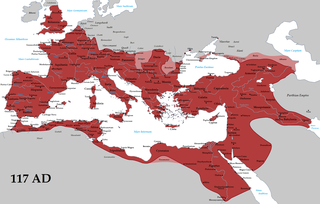
The Roman Empire ruled the Mediterranean and much of Europe, Western Asia and North Africa. The Romans conquered most of this during the Republic, and it was ruled by emperors following Octavian's assumption of effective sole rule in 27 BC. The western empire collapsed in 476 AD, but the eastern empire lasted until the fall of Constantinople in 1453.
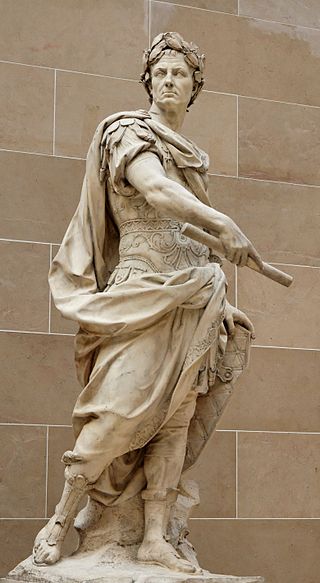
The following outline is provided as an overview of and topical guide to ancient Rome:

The pontifex maximus was the chief high priest of the College of Pontiffs in ancient Rome. This was the most important position in the ancient Roman religion, open only to patricians until 254 BC, when a plebeian first held this position. Although in fact the most powerful office in the Roman priesthood, the pontifex maximus was officially ranked fifth in the ranking of the highest Roman priests, behind the Rex Sacrorum and the flamines maiores.

Lucius Cassius Dio, also known as Dio Cassius, was a Roman historian and senator of maternal Greek origin. He published 80 volumes of the history of ancient Rome, beginning with the arrival of Aeneas in Italy. The volumes documented the subsequent founding of Rome, the formation of the Republic, and the creation of the Empire up until 229 AD, during the reign of Severus Alexander. Written in Ancient Greek over 22 years, Dio's work covers approximately 1,000 years of history.
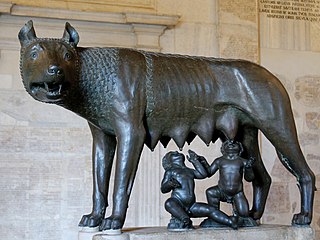
The patricians were originally a group of ruling class families in ancient Rome. The distinction was highly significant in the Roman Kingdom and the early Republic, but its relevance waned after the Conflict of the Orders. By the time of the late Republic and Empire, membership in the patriciate was of only nominal significance. The social structure of ancient Rome revolved around the distinction between the patricians and the plebeians. The status of patricians gave them more political power than the plebeians, but the relationship between the groups eventually caused the Conflict of the Orders. This time period resulted in changing of the social structure of ancient Rome.

The toga, a distinctive garment of Ancient Rome, was a roughly semicircular cloth, between 12 and 20 feet in length, draped over the shoulders and around the body. It was usually woven from white wool, and was worn over a tunic. In Roman historical tradition, it is said to have been the favored dress of Romulus, Rome's founder; it was also thought to have originally been worn by both sexes, and by the citizen-military. As Roman women gradually adopted the stola, the toga was recognized as formal wear for male Roman citizens. Women found guilty of adultery and women engaged in prostitution might have provided the main exceptions to this rule.
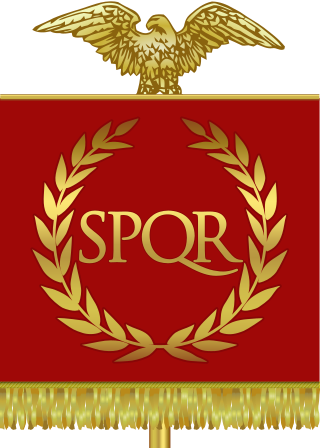
The Roman emperor was the ruler and monarchical head of state of the Roman Empire, starting with the granting of the title Augustus to Octavian in 27 BC. The term "emperor" is a modern convention, and did not exist as such during the Empire. Often when a given Roman is described as becoming emperor in English, it reflects his taking of the title Augustus and later Basileus. Another title used was Imperator, originally a military honorific, and Caesar, originally a cognomen. Early emperors also used the title Princeps alongside other Republican titles, notably consul and Pontifex maximus.

Chariot racing was one of the most popular ancient Greek, Roman, and Byzantine sports. In Greece, chariot racing played an essential role in aristocratic funeral games from a very early time. With the institution of formal races and permanent racetracks, chariot racing was adopted by many Greek states and their religious festivals. Horses and chariots were very costly. Their ownership was a preserve of the wealthiest aristocrats, whose reputations and status benefitted from offering such extravagant, exciting displays. Their successes could be further broadcast and celebrated through commissioned odes and other poetry.
Byzantine art comprises the body of artistic products of the Eastern Roman Empire, as well as the nations and states that inherited culturally from the empire. Though the empire itself emerged from the decline of western Rome and lasted until the Fall of Constantinople in 1453, the start date of the Byzantine period is rather clearer in art history than in political history, if still imprecise. Many Eastern Orthodox states in Eastern Europe, as well as to some degree the Islamic states of the eastern Mediterranean, preserved many aspects of the empire's culture and art for centuries afterward.

The study of the economies of the ancient city-state of Rome and its empire during the Republican and Imperial periods remains highly speculative. There are no surviving records of business and government accounts, such as detailed reports of tax revenues, and few literary sources regarding economic activity. Instead, the study of this ancient economy is today mainly based on the surviving archeological and literary evidence that allow researchers to form conjectures based on comparisons with other more recent pre-industrial economies.

The akakia, previously known as an anexikakia was a cylindrical purple silk roll containing dust which is depicted in wall mosaics and on coinage as being held by Byzantine emperors during ceremonies. It symbolized the mortal nature of all men. It possibly developed from the mappa, the cloth used by the Roman consuls to start the races at the hippodrome.

Byzantine dress changed considerably over the thousand years of the Empire, but was essentially conservative. Popularly, Byzantine dress remained attached to its classical Greek roots with most changes and different styles being evidenced in the upper strata of Byzantine society always with a touch of the Hellenic environment. The Byzantines liked colour and pattern, and made and exported very richly patterned cloth, especially Byzantine silk, woven and embroidered for the upper classes, and resist-dyed and printed for the lower. A different border or trimming round the edges was very common, and many single stripes down the body or around the upper arm are seen, often denoting class or rank. Taste for the middle and upper classes followed the latest fashions at the Imperial Court.

Clothing in ancient Rome generally comprised a short-sleeved or sleeveless, knee-length tunic for men and boys, and a longer, usually sleeved tunic for women and girls. On formal occasions, adult male citizens could wear a woolen toga, draped over their tunic, and married citizen women wore a woolen mantle, known as a palla, over a stola, a simple, long-sleeved, voluminous garment that modestly hung to cover the feet. Clothing, footwear and accoutrements identified gender, status, rank and social class. This was especially apparent in the distinctive, privileged official dress of magistrates, priesthoods and the military.

The Roman Senate was the highest and constituting assembly of ancient Rome and its aristocracy. With different powers throughout its existence it lasted from the first days of the city of Rome as the Senate of the Roman Kingdom, to the Senate of the Roman Republic and Senate of the Roman Empire and eventually the Byzantine Senate of the Eastern Roman Empire, existing well into the post-classical era and Middle Ages.

The Gunthertuch is a Byzantine silk tapestry which represents the triumphal return of a Byzantine Emperor from a victorious campaign. The piece was purchased, or possibly received as a gift, by Gunther von Bamberg, Bishop of Bamberg, during his 1064–65 pilgrimage to the Holy Land. Gunther died on his return journey, and was buried with it in the Bamberg Cathedral. The fabric was rediscovered in 1830, and is now exhibited in the Bamberg Diocesan Museum.

The loros was a long, narrow and embroidered cloth, which was wrapped around the torso and dropped over the left hand. It was one of the most important and distinctive parts of the most formal and ceremonial type of imperial Byzantine costume, worn only by the Imperial family and a few of the most senior officials. It developed out of the trabea triumphalis of the Roman consuls. There were different male and female versions. Byzantine sources speak of the "loros costume" as the loros dictated the rest of the imperial outfit. The slightly less formal, and more secular, imperial costume, which was also that normally worn by high officials on official occasions, was the chlamys costume. Underneath either the loros or the chlamys were worn the divetesion (διβητήσιον), a long silk robe, and a tunic.
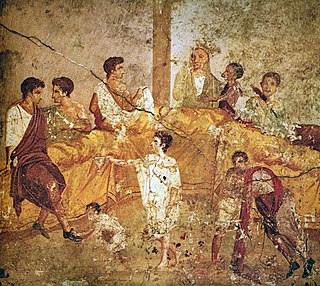
The Roman people was the body of Roman citizens (Latin: Rōmānī; Ancient Greek: Ῥωμαῖοι Rhōmaîoi) during the Roman Kingdom, the Roman Republic, and the Roman Empire. This concept underwent considerable changes throughout the long history of the Roman civilisation, as its borders expanded and contracted. Originally only including the Latins of Rome itself, Roman citizenship was extended to the rest of the Italic peoples by the 1st century BC and to nearly every subject of the Roman empire in late antiquity. At their peak, the Romans ruled large parts of Europe, the Near East, and North Africa through conquests made during the Roman Republic and the subsequent Roman Empire. Although defined primarily as a citizenship, "Roman-ness" has also and variously been described as a cultural identity, a nationality, or a multi-ethnicity that eventually encompassed a vast regional diversity.
Hellenisation in the Byzantine Empire describes the spread and intensification of ancient Greek culture, religion and language in the Roman Empire and which forms the basis of modern historians calling this later period the Byzantine Empire. The theory of Hellenisation generally applies to the influence of foreign cultures subject to Greek influence or occupation, which includes the ethnic and cultural homogenisation which took place throughout the life of the Byzantine Empire (330-1453).
References
- ↑ Wild, J. P. (2002). "The Textile Industries of Roman Britain". Britannia. 33: 1–42. doi:10.2307/1558851. ISSN 1753-5352. JSTOR 1558851.
- ↑ Houston, Mary G. (2003-01-01). Ancient Greek, Roman & Byzantine Costume. Courier Corporation. p. 124. ISBN 978-0-486-42610-5.
- ↑ Strittmatter, Eugene J. (1923). "Classical Elements in the Roman Liturgy". The Classical Journal. 18 (4): 195–207. ISSN 0009-8353. JSTOR 3288702.
- ↑ Sebesta, Judith Lynn; Bonfante, Larissa, eds. (1994). The World of Roman Costume. Univ of Wisconsin Press. p. 35. ISBN 978-0-299-13854-7.
- ↑ Mitchell, Jillian M. "Tickling the Ivories: Aristocratic Representation in Late Antique Rome": 69–71.
{{cite journal}}: Cite journal requires|journal=(help) - ↑ Hoek, Annewies van den (2005). "Anicius Auchenius Bassus, African Red Slip Ware, and the Church". Harvard Theological Review. 98 (2): 171–185. doi:10.1017/S001781600500091X. ISSN 1475-4517. S2CID 154313600.
- ↑ Angelov, Dimiter; Herrin, Judith (2012), Kolodziejczyk, Dariusz; Bang, Peter Fibiger (eds.), "The Christian imperial tradition – Greek and Latin", Universal Empire: A Comparative Approach to Imperial Culture and Representation in Eurasian History, Cambridge: Cambridge University Press, pp. 149–174, ISBN 978-1-139-13695-2 , retrieved 2022-11-03
- ↑ Gilbert Dagron (2007). "From the Mappa to the Akakia: Symbolic Drift". In Hagit Amirav; Bas ter Haar Romeny (eds.). From Rome to Constantinople: Studies in Honor of Averil Cameron. Peeters.
- ↑ Alfred Raymond Bellinger (1973). Leo III to Nicephorus III: 717-1081. p. 169.